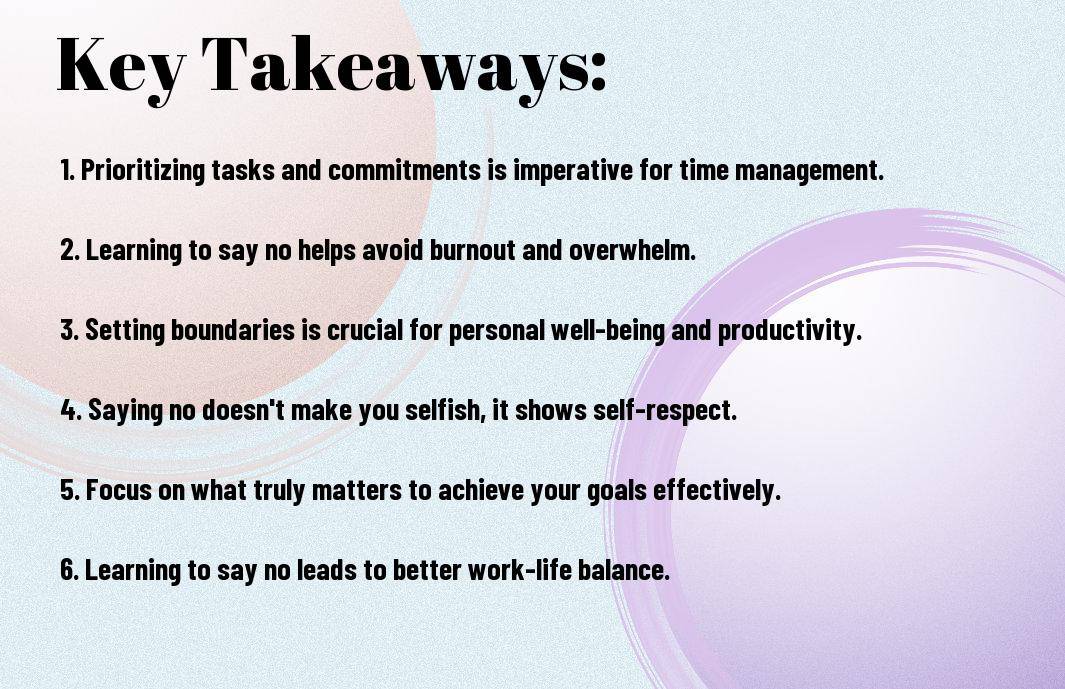Commitments can quickly pile up, overwhelming us with an endless list of tasks and responsibilities. Learning to say no is a crucial skill that can empower individuals to take control of their time and focus on what truly matters. By prioritizing tasks and commitments, individuals can avoid burnout, improve productivity, and maintain a healthy work-life balance.
Key Takeaways:
- Say No when necessary: It is important to prioritize tasks and commitments by learning to decline certain requests or opportunities that do not align with your goals or values.
- Set clear boundaries: Establishing boundaries will help you focus on what truly matters and prevent you from being overwhelmed with too many responsibilities.
- Understand your limits: Recognize your capacity and avoid overcommitting by only taking on tasks that you can realistically handle.
- Focus on what is important: By saying no to less important tasks, you can dedicate more time and energy to the tasks that will have a greater impact on your goals.
- Practice self-care: Prioritizing tasks also means prioritizing your well-being. Saying no allows you to avoid burnout and maintain a healthy work-life balance.
- Communicate effectively: Learn to decline requests politely and assertively, while also offering alternatives or compromises when possible.
- Reflect and reassess regularly: Take time to evaluate your commitments and tasks periodically to ensure that you are staying true to your priorities and making efficient use of your time.

Understanding the Power of No
There’s a common misconception that saying ‘no’ is a negative action. However, learning to say no is crucial for maintaining a healthy balance in our lives. By setting boundaries and prioritizing our tasks and commitments, we are able to focus our energy on what truly matters. Saying no can be empowering, allowing us to take control of our time and reduce feelings of being overwhelmed.
Psychological Implications of Saying No
One of the psychological implications of saying no is the boost it gives to our self-esteem and confidence. When we assert ourselves and decline tasks that do not align with our goals, we demonstrate self-respect and a clear sense of boundaries. This can lead to increased feelings of autonomy and agency in our lives, improving our overall mental well-being.
Societal Expectations and Personal Boundaries
For many of us, societal expectations often dictate our actions, leading us to say ‘yes’ to commitments that we don’t have the capacity for. This can result in burnout, stress, and a sense of being overwhelmed. However, by recognizing our personal boundaries and learning to say no when necessary, we can break free from these harmful patterns and prioritize our well-being.
With practice and perseverance, we can learn to say no with confidence, knowing that it is a valuable skill in maintaining a balanced and fulfilling life. By setting boundaries and prioritizing our tasks, we pave the way for a more focused and intentional existence.

The Art of Prioritizing Tasks
Identifying Core Responsibilities
All successful individuals have one thing in common – they know how to prioritize their tasks effectively. An crucial first step in mastering this skill is identifying your core responsibilities. These are the tasks that directly contribute to your goals, objectives, or obligations. By clarifying what truly matters, you can focus your time and energy on activities that bring the most value.
Techniques for Task Hierarchy
One effective technique for prioritizing tasks is the Eisenhower Matrix. This method categorizes tasks based on urgency and importance, helping you distinguish between what is pressing and what is crucial. Another strategy is the ABCDE method, which involves assigning a priority level to each task. By ranking tasks from A (most important) to E (least important), you can allocate your resources more efficiently.
To ensure effective task prioritization, it is crucial to regularly review and adjust your list of responsibilities as needed. By staying organized and focused on your core objectives, you can achieve optimal productivity and success in both your personal and professional life.

Commitment Assessment Strategies
Analyzing Time and Energy Availability
For effective commitment assessment, it’s crucial to first analyze your availability in terms of time and energy. Assess how much time you realistically have each day to dedicate to additional tasks or projects. Consider your current workload, personal responsibilities, and the amount of energy you have at your disposal. By understanding your limitations, you can avoid overcommitting and experiencing burnout.
Long-Term vs Short-Term Commitment Consequences
To make informed decisions about commitments, it’s imperative to weigh the consequences of long-term versus short-term obligations. Consider the impact a commitment will have not only in the present moment but also in the future. Short-term commitments may offer quick gratification but could lead to long-term stress or overextension. On the other hand, long-term commitments may require patience and sustained effort but can lead to lasting growth and fulfillment.
Plus
When evaluating long-term versus short-term commitment consequences, it’s imperative to prioritize tasks that align with your values and long-term goals. While short-term commitments may offer immediate rewards, long-term commitments often provide more significant benefits in terms of personal growth and professional development.

Assertiveness Training
Now that we understand the significance of learning to say no, it’s time to investigate into the methods and techniques that can help us become more assertive in prioritizing tasks and commitments. Assertiveness training plays a vital role in empowering individuals to set boundaries and communicate effectively in various situations.
Developing the Confidence to Say No
Confidence is key when it comes to saying no. Many individuals struggle with this aspect due to fear of conflict or the desire to please others. By building self-assurance and recognizing the value of our time and energy, we can improve our ability to decline tasks or commitments that do not align with our priorities.
Role-Playing Scenarios for Practice
Confidence in saying no can be enhanced through practice, and role-playing scenarios offer a safe environment to sharpen this skill. Engaging in mock situations where you have to decline a request or set a boundary can help desensitize the anxiety associated with saying no.
To further boost confidence in real-life situations, it’s beneficial to enlist the help of a trusted friend or mentor to act as the requester in these role-playing exercises. Constructive feedback and reflection post-practice can aid in refining your assertiveness skills.
The Impact of Saying No on Personal and Professional Growth
Many individuals struggle with setting boundaries and saying no to tasks and commitments that do not align with their priorities. However, learning to say no is crucial for personal and professional growth. By prioritizing tasks and commitments that are in line with our goals and values, we can focus our time and energy on what truly matters, leading to increased productivity and success.
Case Studies on Successful Boundary Setting
Saying no is not always easy, but several successful individuals have demonstrated the power of setting boundaries. Here are some case studies that showcase the importance of prioritizing tasks and commitments:
- Case Study 1: John Smith, a successful entrepreneur, increased his productivity by 30% after learning to say no to non-vital meetings and tasks.
- Case Study 2: Sarah Johnson, a busy professional, reduced her stress levels by 50% by setting boundaries and only taking on projects that aligned with her long-term career goals.
- Case Study 3: Mark Thompson, a high-level executive, improved his work-life balance by saying no to weekend work commitments, leading to better overall job satisfaction.
Addressing the Fear of Missing Out (FOMO)
With the rise of social media and constant connectivity, many individuals struggle with the fear of missing out (FOMO) when they say no to opportunities or events. Addressing this fear is crucial for setting boundaries and prioritizing tasks effectively. By recognizing that saying no allows us to focus on what truly matters and aligns with our goals, we can overcome FOMO and make decisions that benefit our personal and professional growth.
Personal growth and professional success are closely tied to our ability to prioritize tasks and commitments effectively. By learning to say no and set boundaries, we can focus on what truly matters, leading to increased productivity, reduced stress, and overall satisfaction in our personal and professional lives.
Reinforcing Boundaries with Technology
Keep in mind that technology can be both a great asset and a significant distraction when it comes to reinforcing boundaries and prioritizing tasks. It’s crucial to use technology to your advantage without letting it dictate your time and commitments. By leveraging the right tools and strategies, you can enhance your productivity and focus on what truly matters.
Tools for Managing and Communicating Priorities
Tools such as project management software, to-do list apps, and calendar integrations can help you stay organized and on top of your priorities. Utilize these tools to break down tasks, set deadlines, and communicate your availability to others effectively. Make sure to regularly update and review your priorities to ensure you are on track to meet your goals.
Automating Decisions to Reduce Overwhelm
With the advancements in artificial intelligence and machine learning, you can now automate certain decisions to reduce overwhelm and cognitive load. Delegate repetitive tasks, set up automated reminders, and use algorithms to filter and prioritize incoming information. By offloading these decisions to technology, you can focus your energy on more critical aspects of your work and personal life.
To effectively manage your priorities and boundaries with technology, it’s crucial to strike a balance between utilizing automation and maintaining control over your decisions. While automation can streamline processes and reduce overwhelm, it’s crucial to stay vigilant and regularly review automated settings to ensure they align with your current objectives. By leveraging technology smartly and proactively, you can reinforce your boundaries and prioritize tasks effectively.
Summing up
Considering all points, it is clear that learning to say no and prioritize tasks and commitments is imperative for maintaining a healthy work-life balance and reaching personal and professional goals. By setting boundaries and focusing on what truly matters, individuals can avoid burnout, improve productivity, and reduce stress levels. Utilizing the tips and strategies mentioned in Learn To Say No At Important Times | Know More, one can empower themselves to make informed decisions about where to invest their time and energy.
FAQ
Q: Why is learning to say no important?
A: Learning to say no is important because it helps you prioritize tasks and commitments, avoid burnout, and maintain a healthy work-life balance.
Q: How can learning to say no improve productivity?
A: By saying no to tasks that are not aligned with your goals or priorities, you can focus on what truly matters and increase your productivity.
Q: What are some strategies for saying no effectively?
A: Some strategies for saying no effectively include being assertive but polite, offering alternative solutions, and setting clear boundaries.
Q: How can prioritizing tasks help in decision-making?
A: Prioritizing tasks allows you to identify what needs to be done first, making it easier to make decisions on where to allocate your time and resources.
Q: What are the consequences of not learning to say no?
A: Not learning to say no can lead to overcommitment, stress, and feeling overwhelmed, ultimately affecting your well-being and performance.
Q: How can one overcome the fear of saying no?
A: To overcome the fear of saying no, practice assertiveness, remind yourself of your priorities, and understand that it is okay to decline requests that do not align with your goals.
Q: What role does self-awareness play in learning to say no?
A: Self-awareness is crucial in learning to say no as it helps you understand your limits, priorities, and values, empowering you to make decisions that serve your best interests.
Dive Deeper: Further Explorations for Your Journey
The 10-Minute Rule – A Method to Overcome Procrastination by Starting Small
SMART Goals – George T. Doran’s Method for Setting Clear and Achievable Goals
The 2 Minute Rule – David Allen’s (popularized) Trick to Overcome Procrastination and Start Tasks
The Science of Concentration in The Art of Focus



